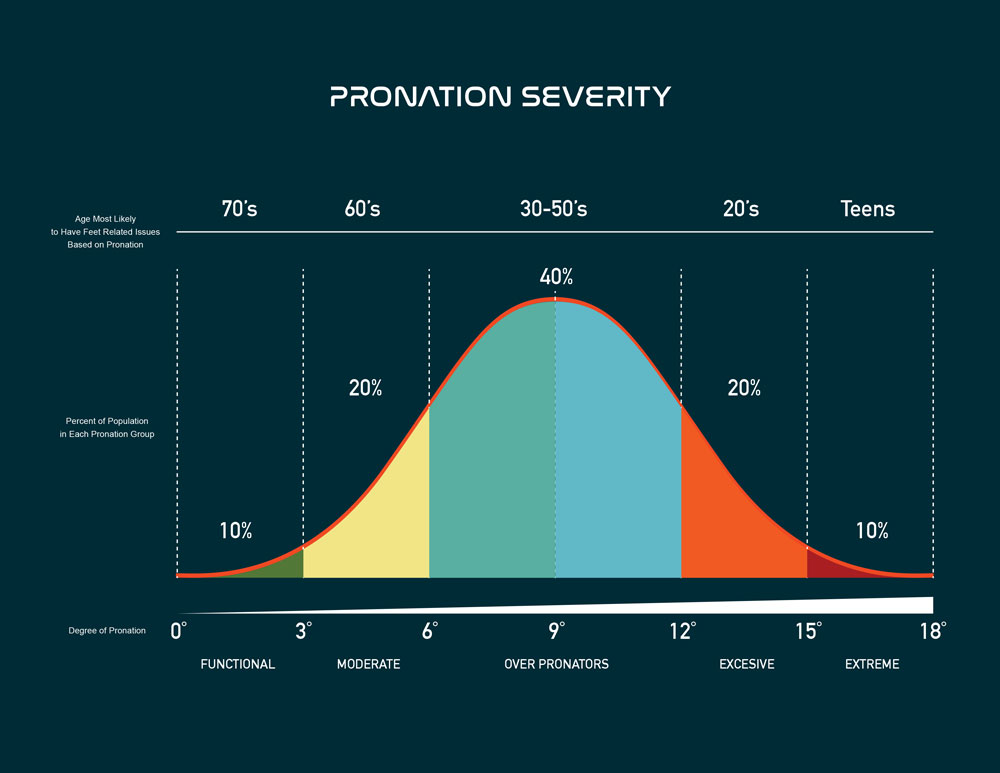Our Science, Precision-Crafted Movement Starts Here
For thousands of years, humans evolved to move across varied, uneven terrain. But today? We live in a world paved flat — sidewalks, stairs, floors, parking lots. It’s efficient, but it comes at a cost. Every time you take a step — roughly 10,000 times a day — your foot has to stabilize on an unnaturally flat surface. And that reveals something your body has been dealing with all along: a built-in structural bias. It’s not your shoes. It’s your bones.
Nearly everyone is born with some degree of pronation — a natural inward roll of the foot. But over time, that small imbalance becomes a big problem. Each step triggers your nervous system to engage supporting muscles to compensate, maintain balance, and keep you moving. Most people never consider this complex, three-part harmony between bones, brain, and muscle. But when your structure is off, your muscles work overtime to compensate — leading to chronic strain, fatigue, and pain that shows up in the feet, ankles, knees, hips, and back.
What can be measured, can be improved
Over the last 25 years, we’ve measured more than 14,000 feet and built a detailed distribution curve showing the real-world range of foot alignment — from 0° to 18°, across all levels of pronation and supination.
Here’s what the data shows:
90% of people have at least one foot that falls outside the optimal “functional zone”
Only 10% have both feet aligned — and that same 10% includes many of the world’s top-performing athletes
At the other end of the spectrum, those with the most severe misalignment often begin to feel discomfort and joint pain as teenagers. As the degree of pronation increases, instability rises, leading to problems in movement — whether on the job, in sport, or everyday life.
Most of our customers find us in their 40s and 50s, after years of compensating for misalignment. By that point, fatigue, imbalance, and discomfort have set in. But the sooner we measure and correct the issue, the better the long-term outcome — especially for young people starting to experience pain in their ankles, knees, or hips.
Where do you fall on the instability chart ?

We Don’t Build Arch Supports. We Build Foundations.

Where is the arch support?
By definition “An arch is a self supported structure. So, if arches support themselves, then WHY do we need to use arch supports ?
Our 3D printed custom foundations (as opposed to arch supports in traditional footbeds) create stability by “leveling” the foot so you strike the ground in a flat, supported way – enabling your muscles and whole body to relax. This simple, yet extremely powerful, and effective fix has proven to alleviate pains, stress/strain on the whole body, improving comfort and balance – with enhanced performance as a by product. Plus, it prevents injuries.
No Two Feet Are the Same
Then why would traditional orthotics or footbeds look exactly the same?
When you go to the eye doctor, he measures each eye and give you glasses or contacts with a specific prescription for each.
The same is true about your feet. Each one hits the ground differently and thus needs to be supported by a footbed ( foundation) with the right angle for that unique foot.
Asymmetric foot support is new in the world of foot assistance. Because we measure feet independently. We have a unique understanding of why one side hurts and the other does not. or vise versa. The kinetic chain has two different sides, one for each foot and the ripple effect of how each one lands on the ground sends asymmetric shock waves through the entire body. Overtime, it turns into chronic pain in the body.
Most don’t connect the dots: when a hip is hurting, it’s probably coming from the way your feet meet the ground.
Take The First Step
Measurements take just 20 minutes in our Aspen location. And when we say it’s life-changing, we mean it. Most of our customers feel the impact from the first step forward.
